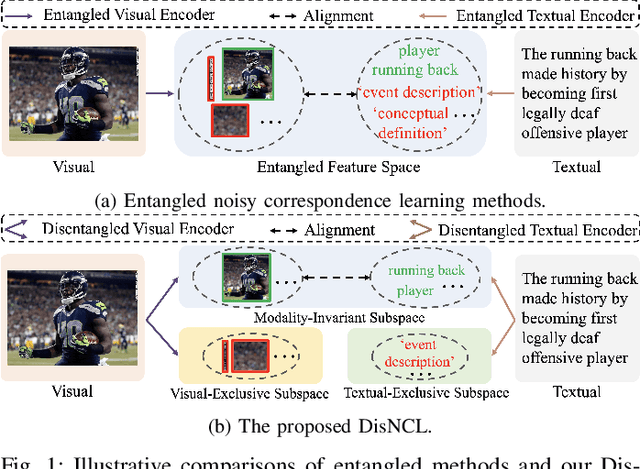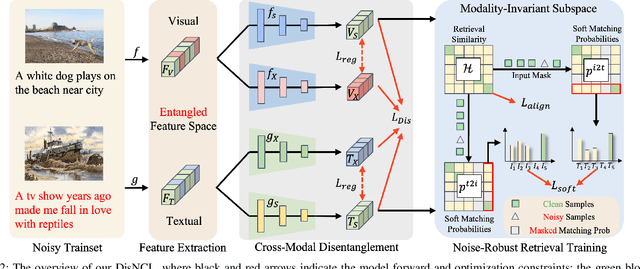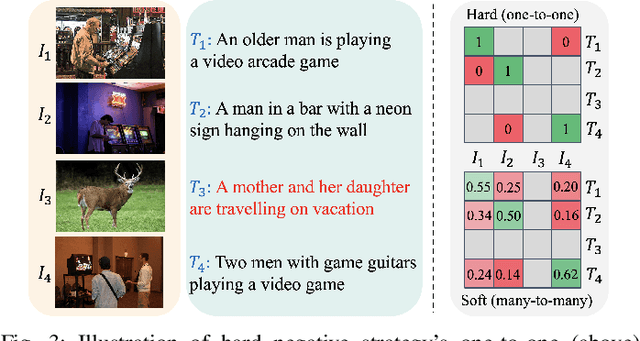Zhuohang Dang
ChatGen: Automatic Text-to-Image Generation From FreeStyle Chatting
Nov 26, 2024Abstract:Despite the significant advancements in text-to-image (T2I) generative models, users often face a trial-and-error challenge in practical scenarios. This challenge arises from the complexity and uncertainty of tedious steps such as crafting suitable prompts, selecting appropriate models, and configuring specific arguments, making users resort to labor-intensive attempts for desired images. This paper proposes Automatic T2I generation, which aims to automate these tedious steps, allowing users to simply describe their needs in a freestyle chatting way. To systematically study this problem, we first introduce ChatGenBench, a novel benchmark designed for Automatic T2I. It features high-quality paired data with diverse freestyle inputs, enabling comprehensive evaluation of automatic T2I models across all steps. Additionally, recognizing Automatic T2I as a complex multi-step reasoning task, we propose ChatGen-Evo, a multi-stage evolution strategy that progressively equips models with essential automation skills. Through extensive evaluation across step-wise accuracy and image quality, ChatGen-Evo significantly enhances performance over various baselines. Our evaluation also uncovers valuable insights for advancing automatic T2I. All our data, code, and models will be available in \url{https://chengyou-jia.github.io/ChatGen-Home}
AgentStore: Scalable Integration of Heterogeneous Agents As Specialized Generalist Computer Assistant
Oct 24, 2024Abstract:Digital agents capable of automating complex computer tasks have attracted considerable attention due to their immense potential to enhance human-computer interaction. However, existing agent methods exhibit deficiencies in their generalization and specialization capabilities, especially in handling open-ended computer tasks in real-world environments. Inspired by the rich functionality of the App store, we present AgentStore, a scalable platform designed to dynamically integrate heterogeneous agents for automating computer tasks. AgentStore empowers users to integrate third-party agents, allowing the system to continuously enrich its capabilities and adapt to rapidly evolving operating systems. Additionally, we propose a novel core \textbf{MetaAgent} with the \textbf{AgentToken} strategy to efficiently manage diverse agents and utilize their specialized and generalist abilities for both domain-specific and system-wide tasks. Extensive experiments on three challenging benchmarks demonstrate that AgentStore surpasses the limitations of previous systems with narrow capabilities, particularly achieving a significant improvement from 11.21\% to 23.85\% on the OSWorld benchmark, more than doubling the previous results. Comprehensive quantitative and qualitative results further demonstrate AgentStore's ability to enhance agent systems in both generalization and specialization, underscoring its potential for developing the specialized generalist computer assistant. All our codes will be made publicly available in https://chengyou-jia.github.io/AgentStore-Home.
Disentangled Noisy Correspondence Learning
Aug 10, 2024



Abstract:Cross-modal retrieval is crucial in understanding latent correspondences across modalities. However, existing methods implicitly assume well-matched training data, which is impractical as real-world data inevitably involves imperfect alignments, i.e., noisy correspondences. Although some works explore similarity-based strategies to address such noise, they suffer from sub-optimal similarity predictions influenced by modality-exclusive information (MEI), e.g., background noise in images and abstract definitions in texts. This issue arises as MEI is not shared across modalities, thus aligning it in training can markedly mislead similarity predictions. Moreover, although intuitive, directly applying previous cross-modal disentanglement methods suffers from limited noise tolerance and disentanglement efficacy. Inspired by the robustness of information bottlenecks against noise, we introduce DisNCL, a novel information-theoretic framework for feature Disentanglement in Noisy Correspondence Learning, to adaptively balance the extraction of MII and MEI with certifiable optimal cross-modal disentanglement efficacy. DisNCL then enhances similarity predictions in modality-invariant subspace, thereby greatly boosting similarity-based alleviation strategy for noisy correspondences. Furthermore, DisNCL introduces soft matching targets to model noisy many-to-many relationships inherent in multi-modal input for noise-robust and accurate cross-modal alignment. Extensive experiments confirm DisNCL's efficacy by 2% average recall improvement. Mutual information estimation and visualization results show that DisNCL learns meaningful MII/MEI subspaces, validating our theoretical analyses.
Noisy Correspondence Learning with Self-Reinforcing Errors Mitigation
Dec 27, 2023Abstract:Cross-modal retrieval relies on well-matched large-scale datasets that are laborious in practice. Recently, to alleviate expensive data collection, co-occurring pairs from the Internet are automatically harvested for training. However, it inevitably includes mismatched pairs, \ie, noisy correspondences, undermining supervision reliability and degrading performance. Current methods leverage deep neural networks' memorization effect to address noisy correspondences, which overconfidently focus on \emph{similarity-guided training with hard negatives} and suffer from self-reinforcing errors. In light of above, we introduce a novel noisy correspondence learning framework, namely \textbf{S}elf-\textbf{R}einforcing \textbf{E}rrors \textbf{M}itigation (SREM). Specifically, by viewing sample matching as classification tasks within the batch, we generate classification logits for the given sample. Instead of a single similarity score, we refine sample filtration through energy uncertainty and estimate model's sensitivity of selected clean samples using swapped classification entropy, in view of the overall prediction distribution. Additionally, we propose cross-modal biased complementary learning to leverage negative matches overlooked in hard-negative training, further improving model optimization stability and curbing self-reinforcing errors. Extensive experiments on challenging benchmarks affirm the efficacy and efficiency of SREM.
Generating Action-conditioned Prompts for Open-vocabulary Video Action Recognition
Dec 04, 2023Abstract:Exploring open-vocabulary video action recognition is a promising venture, which aims to recognize previously unseen actions within any arbitrary set of categories. Existing methods typically adapt pretrained image-text models to the video domain, capitalizing on their inherent strengths in generalization. A common thread among such methods is the augmentation of visual embeddings with temporal information to improve the recognition of seen actions. Yet, they compromise with standard less-informative action descriptions, thus faltering when confronted with novel actions. Drawing inspiration from human cognitive processes, we argue that augmenting text embeddings with human prior knowledge is pivotal for open-vocabulary video action recognition. To realize this, we innovatively blend video models with Large Language Models (LLMs) to devise Action-conditioned Prompts. Specifically, we harness the knowledge in LLMs to produce a set of descriptive sentences that contain distinctive features for identifying given actions. Building upon this foundation, we further introduce a multi-modal action knowledge alignment mechanism to align concepts in video and textual knowledge encapsulated within the prompts. Extensive experiments on various video benchmarks, including zero-shot, few-shot, and base-to-novel generalization settings, demonstrate that our method not only sets new SOTA performance but also possesses excellent interpretability.
Disentangled Representation Learning with Transmitted Information Bottleneck
Nov 03, 2023Abstract:Encoding only the task-related information from the raw data, \ie, disentangled representation learning, can greatly contribute to the robustness and generalizability of models. Although significant advances have been made by regularizing the information in representations with information theory, two major challenges remain: 1) the representation compression inevitably leads to performance drop; 2) the disentanglement constraints on representations are in complicated optimization. To these issues, we introduce Bayesian networks with transmitted information to formulate the interaction among input and representations during disentanglement. Building upon this framework, we propose \textbf{DisTIB} (\textbf{T}ransmitted \textbf{I}nformation \textbf{B}ottleneck for \textbf{Dis}entangled representation learning), a novel objective that navigates the balance between information compression and preservation. We employ variational inference to derive a tractable estimation for DisTIB. This estimation can be simply optimized via standard gradient descent with a reparameterization trick. Moreover, we theoretically prove that DisTIB can achieve optimal disentanglement, underscoring its superior efficacy. To solidify our claims, we conduct extensive experiments on various downstream tasks to demonstrate the appealing efficacy of DisTIB and validate our theoretical analyses.
PSDiff: Diffusion Model for Person Search with Iterative and Collaborative Refinement
Sep 20, 2023



Abstract:Dominant Person Search methods aim to localize and recognize query persons in a unified network, which jointly optimizes two sub-tasks, \ie, detection and Re-IDentification (ReID). Despite significant progress, two major challenges remain: 1) Detection-prior modules in previous methods are suboptimal for the ReID task. 2) The collaboration between two sub-tasks is ignored. To alleviate these issues, we present a novel Person Search framework based on the Diffusion model, PSDiff. PSDiff formulates the person search as a dual denoising process from noisy boxes and ReID embeddings to ground truths. Unlike existing methods that follow the Detection-to-ReID paradigm, our denoising paradigm eliminates detection-prior modules to avoid the local-optimum of the ReID task. Following the new paradigm, we further design a new Collaborative Denoising Layer (CDL) to optimize detection and ReID sub-tasks in an iterative and collaborative way, which makes two sub-tasks mutually beneficial. Extensive experiments on the standard benchmarks show that PSDiff achieves state-of-the-art performance with fewer parameters and elastic computing overhead.
SSMG: Spatial-Semantic Map Guided Diffusion Model for Free-form Layout-to-Image Generation
Aug 20, 2023Abstract:Despite significant progress in Text-to-Image (T2I) generative models, even lengthy and complex text descriptions still struggle to convey detailed controls. In contrast, Layout-to-Image (L2I) generation, aiming to generate realistic and complex scene images from user-specified layouts, has risen to prominence. However, existing methods transform layout information into tokens or RGB images for conditional control in the generative process, leading to insufficient spatial and semantic controllability of individual instances. To address these limitations, we propose a novel Spatial-Semantic Map Guided (SSMG) diffusion model that adopts the feature map, derived from the layout, as guidance. Owing to rich spatial and semantic information encapsulated in well-designed feature maps, SSMG achieves superior generation quality with sufficient spatial and semantic controllability compared to previous works. Additionally, we propose the Relation-Sensitive Attention (RSA) and Location-Sensitive Attention (LSA) mechanisms. The former aims to model the relationships among multiple objects within scenes while the latter is designed to heighten the model's sensitivity to the spatial information embedded in the guidance. Extensive experiments demonstrate that SSMG achieves highly promising results, setting a new state-of-the-art across a range of metrics encompassing fidelity, diversity, and controllability.
Disentangled Generation with Information Bottleneck for Few-Shot Learning
Nov 29, 2022



Abstract:Few-shot learning (FSL), which aims to classify unseen classes with few samples, is challenging due to data scarcity. Although various generative methods have been explored for FSL, the entangled generation process of these methods exacerbates the distribution shift in FSL, thus greatly limiting the quality of generated samples. To these challenges, we propose a novel Information Bottleneck (IB) based Disentangled Generation Framework for FSL, termed as DisGenIB, that can simultaneously guarantee the discrimination and diversity of generated samples. Specifically, we formulate a novel framework with information bottleneck that applies for both disentangled representation learning and sample generation. Different from existing IB-based methods that can hardly exploit priors, we demonstrate our DisGenIB can effectively utilize priors to further facilitate disentanglement. We further prove in theory that some previous generative and disentanglement methods are special cases of our DisGenIB, which demonstrates the generality of the proposed DisGenIB. Extensive experiments on challenging FSL benchmarks confirm the effectiveness and superiority of DisGenIB, together with the validity of our theoretical analyses. Our codes will be open-source upon acceptance.
 Add to Chrome
Add to Chrome Add to Firefox
Add to Firefox Add to Edge
Add to Edge